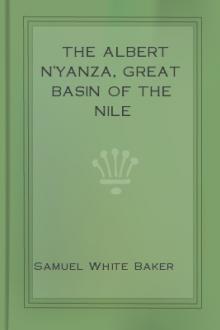The Albert N'Yanza, Great Basin of the Nile, Samuel White Baker [inspirational novels .TXT] 📗

- Author: Samuel White Baker
- Performer: -
Book online «The Albert N'Yanza, Great Basin of the Nile, Samuel White Baker [inspirational novels .TXT] 📗». Author Samuel White Baker
the races that exist upon that surface should be unaltered from their
origin. That origin may date from a period so distant, that it preceded
the Adamite creation. Historic man believes in a Divinity; the tribes of
Central Africa know no God. Are they of our Adamite race? The equatorial
portion of Africa at the Nile sources has an average altitude above the
sea-level of about 4,000 feet; this elevated plateau forms the base of a
range of mountains, that I imagine extends, like the vertebrae of an
animal, from east to west, shedding a drainage to the north and south.
Should this hypothesis be correct, the southern watershed would fill the
Tanganika lake: while farther to the west another lake, supplied by the
southern drainage, may form the head of the river Congo. On the north a
similar system may drain into the Niger and Lake Tchad: thus the
Victoria and the Albert lakes, being the two great reservoirs or sources
of the Nile, may be the first of a system of African equatorial lakes
fed by the northern and southern drainage of the mountain range, and
supplying all the principal rivers of Africa from the great equatorial
rainfall. The fact of the centre of Africa at the Nile sources being
about 4,000 feet above the ocean, independently of high mountains rising
from that level, suggests that the drainage of the Equator from the
central and elevated portion must find its way to the lower level and
reach the sea. Wherever high mountain ranges exist, there must also be
depressions; those situated in an equatorial rainfall must receive the
drainage from the high lands and become lakes, the overflow of which
must form the sources of rivers, precisely as exemplified in the sources
of the Nile from the Victoria and the Albert lakes.
The fact that Sir Roderick Murchison, as a geologist, laid down a theory
of the existence of a chain of lakes upon an elevated plateau in Central
Africa, which theory has been now in great measure confirmed by actual
inspection, induces me to quote an extract from his address at the
anniversary meeting of the Royal Geographical Society, 23d May, 1864. In
that address, he expressed opinions upon the geological structure and
the races of Central Africa, which preceded those that I formed when at
the Albert lake. It is with intense interest that I have read the
following extract since my return to England:—
“In former addresses, I suggested that the interior mass and central
portions of Africa constituting a great plateau occupied by lakes and
marshes from which the waters escaped by cracks or depressions in the
subtending older rocks, had been in that condition during an enormously
long period. I have recently been enabled, through the apposite
discovery of Dr. Kirk, the companion of Livingstone, not only to fortify
my conjecture of 1852, but greatly to extend the inferences concerning
the long period of time during which the central parts of Africa have
remained in their present condition, save their degradation by ordinary
atmospheric agencies. My view, as given to this Society in 1852, was
mainly founded on the original and admirable geological researches of
Mr. Bain in the colony of the Cape of Good Hope. It was, that, inasmuch
as in the secondary or mesozoic age of geologists, the northern interior
of that country was occupied by great lakes and marshes, as proved by
the fossil reptile discovered by Bain, and named Dicynodon by Owen, such
it has remained for countless ages, even up to the present day. The
succeeding journeys into the interior, of Livingstone, Thornton and
Kirk, Burton and Speke, and Speke and Grant, have all tended to
strengthen me in the belief that Southern Africa has not undergone any
of those great submarine depressions which have so largely affected
Europe, Asia, and America, during the secondary, tertiary, and quasi
modern periods.
“The discovery of Dr. Kirk has confirmed my conclusion. On the banks of
an affluent of the Zambesi, that gentleman collected certain bones,
apparently carried down in watery drifts from inland positions, which
remains have been so fossilized as to have all the appearance of
antiquity which fossils of a tertiary or older age usually present. One
of these is a portion of the vertebral column and sacrum of a buffalo,
undistinguishable from that of the Cape buffalo; another is a fragment
of a crocodile, and another of a water-tortoise, both undistinguishable
from the forms of those animals now living. Together with these, Dr.
Kirk found numerous bones of antelopes and other animals, which, though
in a fossil condition, all belonged, as he assured me, to species now
living in South Africa.
“On the other hand, none of our explorers, including Mr. Bain, who has
diligently worked as a geologist, have detected in the interior any
limestones containing marine fossil remains, which would have proved
that South Africa had, like other regions, been depressed into oceanic
conditions, and re-elevated. On the contrary, in addition to old
granitic and other igneous rocks, all explorers find only either
innumerable undulations of sandstones, schistose, and quartzose rocks,
or such tufaceous and ferruginous deposits as would naturally occur in
countries long occupied by lakes and exuberant jungles, separated from
each other by sandy hills, scarcely any other calcareous rocks being
found except tufas formed by the deposition of landsprings. It is true
that there are marine tertiary formations on the coasts (around the Cape
Colony, near the mouth of the Zambesi opposite Mozambique, and again on
the coasts of Mombas opposite Zanzibar), and that these have been raised
up into low-coast ranges, followed by rocks of igneous origin. But in
penetrating into the true interior, the traveller takes a final leave of
all such formations; and in advancing to the heart of the continent, he
traverses a vast region which, to all appearance, has ever been under
terrestrial and lacustrine conditions only. Judging, indeed, from all
the evidences as yet collected, the interior of South Africa has
remained in that condition since the period of the secondary rocks of
geologists! Yet, whilst none of our countrymen found any evidences of
old marine remains, Captain Speke brought from one of the ridges which
lay between the coast and the lake Victoria N’yanza a fossil shell,
which, though larger in size, is undistinguishable from the Achatina
perdix now flourishing in South Africa. Again, whilst Bain found fossil
plants in his reptiliferous strata north of the Cape, and Livingstone
and Thornton discovered coal in sandstone, with fossil plants, like
those of our old coal of Europe and America,—yet both these mesozoic
and palaeozoic remains are terrestrial, and are not associated with
marine limestones, indicative of those oscillations of the land which
are so common in other countries.
“It is further to be observed, that the surface of this vast interior is
entirely exempt from the coarse superficial drift that encumbers so many
countries, as derived from lofty mountain-chains from which either
glaciers or great torrential streams have descended. In this respect, it
is also equally unlike those plains of Germany, Poland, and Northern
Russia, which were sea-bottoms when floating icebergs melted and dropped
the loads of stone which they were transporting from Scandinavia and
Lapland.
“In truth, therefore, the inner portion of Southern Africa is, in this
respect, as far as I know, geologically unique in the long conservation
of ancient terrestrial conditions. This inference is further supported
by the concomitant absence, throughout the larger portion of all this
vast area, i.e. south of the Equator, of any of those volcanic rocks
which are so often associated with oscillations of the terra firma
[“Although Kilimandjaro is to a great extent igneous and volcanic, there
is nothing to prove it has been in activity during the historic era.”]
“With the exception of the true volcanic hills of the Cameroons recently
described by Burton, on the west coast, a little to the north of the
Equator, and which possibly may advance southwards towards the Gaboon
country, nothing is known of the presence of any similar foci of
sub-aerial eruption all round the coasts of Africa south of the Equator.
If the elements for the production of them had existed, the coast-line
is precisely that on which we should expect to find such volcanic vents,
if we judge by the analogy of all volcanic regions where the habitual
igneous eruptions are not distant from the sea, or from great internal
masses of water. The absence, then, both on the coasts and in the
interior, of any eruptive rocks which can have been thrown up under the
atmosphere since the period when the tertiary rocks began to be
accumulated, is in concurrence with all the physical data as yet got
together. These demonstrate that, although the geologist finds here none
of those characters of lithological structure and curiously diversified
organic remains which enable him to fix the epochs of succession in the
crust of the earth in other quarters of the globe, the interior of South
Africa is unquestionably a grand type of a region which has preserved
its ancient terrestrial conditions during a very long period, unaffected
by any changes except those which are dependent on atmospheric and
meteoric influences.
“If, then, the lower animals and plants of this vast country have gone
on unchanged for a very long period, may we infer that its human
inhabitants are of like antiquity? If so, the Negro may claim as old a
lineage as the Caucasian or Mongolian races. In the absence of any
decisive fact, I forbear, at present, to speculate on this point; but
as, amid the fossil specimens procured by Livingstone and Kirk, there
are fragments of pottery made by human hands, we must wait until some
zealous explorer of Southern Africa shall distinctly bring forward
proofs that the manufactured articles are of the same age as the fossil
bones. In other words, we still require from Africa the same proofs of
the existence of links which bind together the sciences of Geology and
Archaeology which have recently been developed in Europe. Now, if the
unquestioned works of man should be found to be coeval with the remains
of fossilized existing animals in Southern Africa, the travelled
geographer, who has convinced himself of the ancient condition of its
surface, must admit, however unwillingly, that although the black man is
of such very remote antiquity, he has been very stationary in
civilization and in attaining the arts of life, if he be compared with
the Caucasian, the Mongolian, the Red Indian of America, or even with
the aborigines of Polynesia.” (“The most remarkable proof of the
inferiority of the Negro, when compared with the Asiatic, is, that
whilst the latter has domesticated the elephant for ages, and rendered
it highly useful to man, the Negro has only slaughtered the animal to
obtain food or ivory.”)
CHAPTER XIX.
THE BLACK ANTELOPE.
We continued our voyage down the Nile, at times scudding along with a
fair wind and stream, when a straight portion of the river allowed our
men respite from the oars. This was the termination of the dry season,
in this latitude 7 degrees (end of March);—thus, although the river
was nearly level with the banks, the marshes were tolerably firm, and in
the dryer portions the reeds had been burnt off by the natives. In one
of these cleared places we descried a vast herd of antelopes, numbering
several thousands. The males were black, and carried fine horns, while
the females were reddish-brown and without horns. Never having shot this
species, I landed from the boat, which I ordered to wait in a sheltered
nook, while, accompanied by the boy Saat and Richarn, I took the little
Fletcher 24 rifle and commenced a stalk.
The antelopes did not evince their usual shyness, and with a





Comments (0)